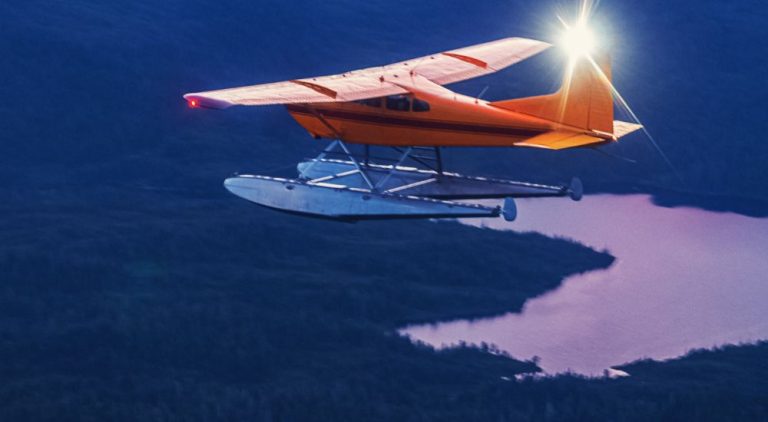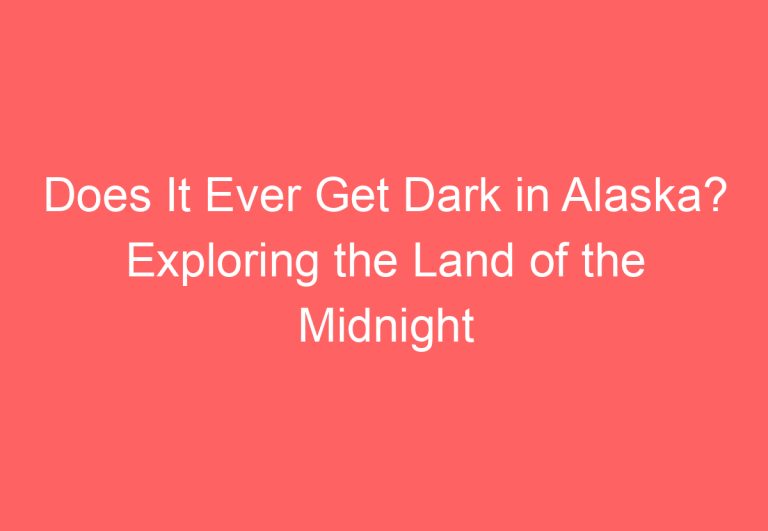How Long Does Alaska Stay Dark? Understanding the State’s Unique Light Conditions
Alaska is known for its unique geography, harsh climate, and long periods of darkness. People often wonder how long Alaska stays dark and how it affects the daily lives of its residents. The answer is not straightforward, as it depends on the specific location and time of year.

In general, Alaska experiences long periods of darkness during the winter months and long periods of daylight during the summer months. The further north you go, the longer the periods of darkness and daylight become. For example, the northernmost city in Alaska, Utqiaġvik (formerly known as Barrow), experiences nearly two months of complete darkness during the winter solstice. However, not all parts of Alaska experience such extreme darkness.
Understanding Alaska’s Unique Daylight Cycle

Alaska’s daylight cycle is one of the most unique in the world. Due to its location in the far north, Alaska experiences extreme seasonal changes in daylight, with periods of continuous daylight and darkness. In this section, we will explore the phenomenon of polar night and midnight sun, seasonal changes in daylight, and geographical influence on daylight.
The Phenomenon of Polar Night and Midnight Sun
Alaska is located above the Arctic Circle, which means that during the winter solstice, the sun never rises above the horizon. This period is known as polar night, and it can last for up to 67 days in the northernmost parts of the state. Conversely, during the summer solstice, the sun never sets below the horizon, resulting in 24 hours of daylight. This period is known as the midnight sun.
Seasonal Changes in Daylight
Alaska experiences extreme seasonal changes in daylight due to its location in the far north. During the winter months, the state experiences shorter days and longer nights, while during the summer months, the state experiences longer days and shorter nights. The changes in daylight are most extreme in the northern parts of the state, where the difference between the longest and shortest day can be up to 22 hours.
Geographical Influence on Daylight
The amount of daylight in Alaska also varies depending on the geographical location. In the northernmost parts of the state, such as Barrow, the sun never rises above the horizon during the winter solstice, resulting in a period of continuous darkness. In the southern parts of the state, such as Anchorage, the state experiences shorter days and longer nights during the winter months, but still receives a few hours of daylight. The interior and southcentral parts of the state experience more moderate changes in daylight, while the southeast part of the state experiences the least extreme changes.
Overall, Alaska’s unique daylight cycle is a result of its location above the Arctic Circle. While the extreme changes in daylight may seem daunting, Alaskans have learned to adapt and embrace the unique beauty of their state’s natural phenomena.
Life in Alaska During Darker Months

Alaska is known for its long, dark winters. During the darker months, Alaskans must adapt to the unique challenges presented by the lack of sunlight. In this section, we will explore how Alaskans cope with extended darkness, the cultural and social adaptations, and tourism and activities available in low light conditions.
Coping with Extended Darkness
Alaskans cope with extended darkness in a variety of ways. Many people take vitamin D supplements to make up for the lack of sunlight, as the body needs sunlight to produce this essential vitamin. Others combat depression by using special lamps that simulate sunlight.
Blackout curtains are also popular in Alaska, as they help to keep out the darkness and create a more welcoming environment. Alaskans are also mindful of their energy usage during the darker months, as heating and lighting costs can be high.
Cultural and Social Adaptations
Alaskans have developed a unique culture that thrives in the darker months. Sourdoughs, or long-time Alaskans, have learned to adapt to the harsh winters by embracing outdoor activities such as skiing, snowshoeing, and ice fishing.
The northern lights, or aurora borealis, are also a popular attraction during the darker months. Many Alaskans gather together to watch the colorful display in the sky, which can be seen throughout the state.
Tourism and Activities in Low Light Conditions
Despite the darkness, Alaska remains a popular destination for tourists during the winter months. Visitors can take part in a variety of outdoor activities, including dog sledding, snowmobiling, and visiting the Mendenhall Glacier.
Tour operators also offer tours specifically designed for low light conditions, such as night-time snowshoeing and aurora viewing. Visitors can also take part in cultural activities, such as learning about the history of Alaska’s native peoples.
In conclusion, while the darkness in Alaska during the winter months can be challenging, Alaskans have learned to adapt and thrive in the unique environment. Visitors can take part in a variety of activities and experiences that are only available during the darker months, making Alaska a truly unique destination.
Frequently Asked Questions

What is the duration of darkness during Alaskan winters?
The duration of darkness during Alaskan winters varies depending on the location in Alaska. The northernmost city of Utqiaġvik experiences 60-plus days of near-constant darkness from mid- to late November until late January, with the sun never rising during that period. However, in Anchorage, the state’s largest city, the night lasts around 18 hours during the peak of winter.
During which months does Alaska experience extended darkness?
Alaska experiences extended darkness during the winter months, typically from late November to late January. However, the duration of darkness varies depending on the location in Alaska.
What are the daylight hours like in Alaska throughout the year?
Alaska experiences extreme variations in daylight hours throughout the year. During the summer months, the northernmost city of Utqiaġvik experiences 24-hour daylight for 82 days straight, while in the winter months, the state experiences extended darkness, with some areas experiencing near-constant darkness for over two months.
How long does the ‘night’ last in Anchorage during the peak of winter?
In Anchorage, the state’s largest city, the night lasts around 18 hours during the peak of winter. However, the duration of darkness varies depending on the location in Alaska.
What is the shortest day experienced in Alaska, and when does it occur?
The shortest day experienced in Alaska is on December 21, the winter solstice. On this day, the state experiences a range of daylight hours depending on the location, with some areas experiencing only a few hours of daylight.
Is it a myth that Alaska has continuous darkness for six months?
Yes, it is a myth that Alaska has continuous darkness for six months. Only the most extreme poles of the earth have a full six months of darkness and six months of light, and no part of Alaska is north enough to experience this phenomenon. However, some areas in Alaska do experience near-constant darkness for over two months during the winter months.






